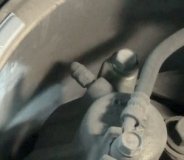If the pedal is firm and high as normal the most likely cause is glazed linings. That reduces the "coefficient of friction". It is caused mostly by overheating the linings, then the binders or glue melts and creates a varnish-like coating on the surface. Sanding the linings with course sandpaper may help but I've had the best luck by just taking a very light cut on the rotors on the brake lathe. The resulting rough surface will grind off the glazing on the pads within a few miles.
If the pedal is going lower than normal you may have rear drum brake shoes that have not been adjusting up automatically. The clue is the pedal will get higher when you pump it rapidly a few times.
Due to the age of the vehicle also consider the possibility of a seized rear wheel cylinder. The certain giveaway is surface rust buildup inside the drum but only if both pistons are stuck. The pedal will be higher than normal since no fluid is moving to that wheel.
Saturday, April 13th, 2013 AT 2:23 AM


